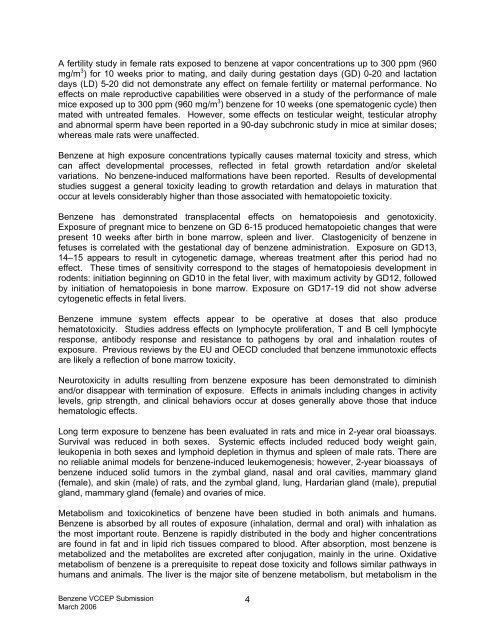(VCCEP) Tier 1 Pilot Submission for BENZENE - Tera
(VCCEP) Tier 1 Pilot Submission for BENZENE - Tera
(VCCEP) Tier 1 Pilot Submission for BENZENE - Tera
You also want an ePaper? Increase the reach of your titles
YUMPU automatically turns print PDFs into web optimized ePapers that Google loves.
A fertility study in female rats exposed to benzene at vapor concentrations up to 300 ppm (960<br />
mg/m 3 ) <strong>for</strong> 10 weeks prior to mating, and daily during gestation days (GD) 0-20 and lactation<br />
days (LD) 5-20 did not demonstrate any effect on female fertility or maternal per<strong>for</strong>mance. No<br />
effects on male reproductive capabilities were observed in a study of the per<strong>for</strong>mance of male<br />
mice exposed up to 300 ppm (960 mg/m 3 ) benzene <strong>for</strong> 10 weeks (one spematogenic cycle) then<br />
mated with untreated females. However, some effects on testicular weight, testicular atrophy<br />
and abnormal sperm have been reported in a 90-day subchronic study in mice at similar doses;<br />
whereas male rats were unaffected.<br />
Benzene at high exposure concentrations typically causes maternal toxicity and stress, which<br />
can affect developmental processes, reflected in fetal growth retardation and/or skeletal<br />
variations. No benzene-induced mal<strong>for</strong>mations have been reported. Results of developmental<br />
studies suggest a general toxicity leading to growth retardation and delays in maturation that<br />
occur at levels considerably higher than those associated with hematopoietic toxicity.<br />
Benzene has demonstrated transplacental effects on hematopoiesis and genotoxicity.<br />
Exposure of pregnant mice to benzene on GD 6-15 produced hematopoietic changes that were<br />
present 10 weeks after birth in bone marrow, spleen and liver. Clastogenicity of benzene in<br />
fetuses is correlated with the gestational day of benzene administration. Exposure on GD13,<br />
14–15 appears to result in cytogenetic damage, whereas treatment after this period had no<br />
effect. These times of sensitivity correspond to the stages of hematopoiesis development in<br />
rodents: initiation beginning on GD10 in the fetal liver, with maximum activity by GD12, followed<br />
by initiation of hematopoiesis in bone marrow. Exposure on GD17-19 did not show adverse<br />
cytogenetic effects in fetal livers.<br />
Benzene immune system effects appear to be operative at doses that also produce<br />
hematotoxicity. Studies address effects on lymphocyte proliferation, T and B cell lymphocyte<br />
response, antibody response and resistance to pathogens by oral and inhalation routes of<br />
exposure. Previous reviews by the EU and OECD concluded that benzene immunotoxic effects<br />
are likely a reflection of bone marrow toxicity.<br />
Neurotoxicity in adults resulting from benzene exposure has been demonstrated to diminish<br />
and/or disappear with termination of exposure. Effects in animals including changes in activity<br />
levels, grip strength, and clinical behaviors occur at doses generally above those that induce<br />
hematologic effects.<br />
Long term exposure to benzene has been evaluated in rats and mice in 2-year oral bioassays.<br />
Survival was reduced in both sexes. Systemic effects included reduced body weight gain,<br />
leukopenia in both sexes and lymphoid depletion in thymus and spleen of male rats. There are<br />
no reliable animal models <strong>for</strong> benzene-induced leukemogenesis; however, 2-year bioassays of<br />
benzene induced solid tumors in the zymbal gland, nasal and oral cavities, mammary gland<br />
(female), and skin (male) of rats, and the zymbal gland, lung, Hardarian gland (male), preputial<br />
gland, mammary gland (female) and ovaries of mice.<br />
Metabolism and toxicokinetics of benzene have been studied in both animals and humans.<br />
Benzene is absorbed by all routes of exposure (inhalation, dermal and oral) with inhalation as<br />
the most important route. Benzene is rapidly distributed in the body and higher concentrations<br />
are found in fat and in lipid rich tissues compared to blood. After absorption, most benzene is<br />
metabolized and the metabolites are excreted after conjugation, mainly in the urine. Oxidative<br />
metabolism of benzene is a prerequisite to repeat dose toxicity and follows similar pathways in<br />
humans and animals. The liver is the major site of benzene metabolism, but metabolism in the<br />
Benzene <strong>VCCEP</strong> <strong>Submission</strong><br />
March 2006<br />
4





